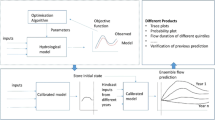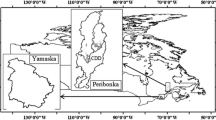Abstract
Ensemble streamflow prediction (ESP) has been widely used to gain insight on possible future inflows to hydropower reservoirs. However underestimation of climate, model structure and initial condition uncertainty often leads to under-dispersed ESP forecasts. In this paper, we present a novel approach called “Hindcast-mode Uncertainty Estimation” (HUE) to efficiently add variability in ESP forecasts to reduce their under-dispersion. The method was tested on a Canadian catchment used by Rio Tinto – Aluminium division to produce hydropower for their aluminium smelting plants. This project was focused on correcting long-term predictions of freshet runoff volumes to optimize drawdown volumes, with up to 6 months of lead time. It was found that by adding an error term to the hydrological model’s snow water equivalent (SWE) state variable at the time of forecast in hindcasting mode, the resulting simulation could be forced to perfectly reproduce the freshet runoff volume. This error term was computed for all years on record which enabled modeling of the error’s distribution. This distribution can then be sampled from to add noise to the model’s SWE at the start of a new ESP forecast. Results show that the current winter ESP forecasts are strongly under-dispersed for the freshet runoff volume estimation and that the proposed method is able to widen the ESPs to correct the under-dispersion problem. This was validated by using Talagrand diagrams which shifted from a U-shape (prior to HUE) to a uniform distribution (with HUE). The project objectives of correcting the ESP forecast’s under-dispersion in spring runoff estimations was thus attained with minimal effort, bypassing the need to perform more complex ensemble data assimilation techniques.






Similar content being viewed by others
References
Arsenault R, Malo J-S, Brissette F, Minville M, Leconte R (2013) Structural and non-structural climate change adaptation strategies for the Péribonka water resource system. Water Resour Manag 27(7):2075–2087
Boucher M-A, Anctil F, Perreault L, Tremblay D (2011) A comparison between ensemble and deterministic hydrological forecasts in an operational context. Adv Geosci 29:85–94. doi:10.5194/adgeo-29-85-2011
Boucher M-A, Perreault L, Anctil F, Favre A-C (2015) Exploratory analysis of statistical post-processing methods for hydrological ensemble forecasts. Hydrol Process 29(6):1141–1155
Brent RP (1973) Algorithms for minimization without derivatives. Prentice-Hall, Englewood Cliffs, New Jersey
Bröcker J, Smith LA (2008) From ensemble forecasts to predictive distribution functions. Tellus A 60:663–678
Charbonneau R, Fortin J-P, Morin G (1977) Le modèle CEQUEAU: description et exemples d’utilisation dans le cadre de problèmes reliés à l’aménagement [description and examples of its use in problems related to water resource management]. Hydrol Sci Bull 22(1):193–202
Chen J, Brissette FP (2015) Combining stochastic weather generation and ensemble weather forecasts for short-term streamflow prediction. Water Resour Manag 29(9):3329–3342
Chen J, Brissette FP, Li Z (2014) Postprocessing of ensemble weather forecasts using a stochastic weather generator. Mon Wea Rev 142:1106–1124. doi:10.1175/MWR-D-13-00180.1
Clark MP, Hay LE (2004) Use of medium-range numerical weather prediction model output to produce forecasts of streamflow. J Hydrometeorol 5:15–32
Côté P, Leconte R (2015) Comparison of Stochastic Optimization Algorithms for Hydropower Reservoir Operation with Ensemble Streamflow Prediction. J Water Resour Plann Manage. doi:10.1061/(ASCE)WR.1943-5452.0000575, 04015046
Côté P, Haguma D, Leconte R, Krau S (2011) Stochastic optimization of hydro-Quebec hydropower installations: a statistical comparison between SDP and SSDP methods. Can J Civil Eng 38(12):1427–1434
Day GN (1985) Extended streamflow forecasting using NWSRFS. J Water Resour Plan Manag 111:157–170
DeChant C, Moradkhani H (2011) Improving the characterization of initial condition for ensemble streamflow prediction using data assimilation. Hydrol Earth Syst Sc 15:3399–3410. doi:10.5194/hess-15-3399
DeChant C, Moradkhani H (2014) Toward a reliable prediction of seasonal forecast uncertainty: addressing model and initial condition uncertainty with ensemble data assimilation and sequential Bayesian combination. J Hydrol 519(D):2967–2977
Desreumaux Q, Côté P, Leconte R (2014) Role of hydrologic information in stochastic dynamic programming: a case study of the Kemano hydropower system in British Columbia. Can J Civil Eng 41(9):839–844
Faber BA, Stedinger JR (2001) Reservoir optimization using sampling SDP with ensemble streamflow prediction (ESP) forecasts. J Hydrol 249(1–4):113–133. doi:10.1016/S0022-1694(01)00419-X
Forsythe GE, Malcolm MA, Moler CB (1977) Computer methods for mathematical computations. Prentice-Hall, Englewood Cliffs, New Jersey
Fortin V, Favre A-C, Saïd M (2006) Probabilistic forecasting from ensemble prediction systems: improving upon the best-member method by using a different weight and dressing kernel for each member. Q J Roy Meteor Soc 132(617):1349–1369
Franz KJ, Hogue TS, Sorooshian S (2008) Snow model verification using ensemble prediction and operational benchmarks. J Hydrometeorol 9:1402–1415
Gneiting T, Raftery A-E, Westveld A-H, Goldman T (2005) Calibrated probabilistic forecasting using ensemble model output statistics and minimum CRPS estimation. Mon Wea Rev 133(5):1098–1118
Hamill TM (2001) Interpretation of rank histograms for verifying ensemble forecasts. Mon Wea Rev 129:550–560. doi:10.1175/1520-0493(2001)129<0550:IORHFV>2.0.CO;2
Hashino T, Bradley AA, Schwartz SS (2007) Evaluation of bias-correction methods for ensemble streamflow volume forecasts. Hydrol Earth Syst Sci 11:939–950. doi:10.5194/hess-11-939-2007
Jones MC, Marron JS, Sheather SJ (1996) A brief survey of bandwidth selection for density estimation. J Am Stat Assoc 91(433):401–407
Liu Y, Gupta HV (2007) Uncertainty in hydrologic modeling: toward an integrated data assimilation framework. Water Resour Res 43:W07401. doi:10.1029/2006WR005756
Liu Z, Guo Y, Wang L, Wang Q (2015) Streamflow forecast errors and their impacts on forecast-based reservoir flood control. Water Resour Manag 29(12):4557–4572
Matheson JE, Winkler RL (1976) Scoring rules for continuous probability distributions. Manag Sci 22(10):1087–1096
Najafi MR, Moradkhani H (2015) Ensemble Combination of Seasonal Streamflow Forecasts. J Hydrol Eng. doi:10.1061/(ASCE)HE.1943-5584.0001250, 04015043
Najafi MR, Moradkhani H, Piechota TC (2012) Ensemble streamflow prediction: climate signal weighting methods vs. Climate Forecast System Reanalysis J Hydrol 442–443:105–116. doi:10.1016/j.jhydrol.2012.04.003
Pagano TC, Shrestha D, Wang Q, Robertson D, Hapuarachchi P (2013) Ensemble dressing for hydrological applications. Hydrol Process 27(1):106–116
Poulin A, Brissette F, Leconte R, Arsenault R, Malo JS (2011) Uncertainty of hydrological modelling in climate change impact studies in a Canadian, snow-dominated river basin. J Hydrol 409(3–4):626–636
Raftery A, Gneiting T, Balabdaoui F, Polakowski M (2005) Using Bayesian model averaging to calibrate forecast ensembles. Mon Wea Rev 133(5):1155–1174
Roulin E, Vannitsem S (2015) Post-processing of medium-range probabilistic hydrological forecasting: impact of forcing, initial conditions and model errors. Hydrol Process 29:1434–1449. doi:10.1002/hyp.10259
Roulston MS, Smith L-A (2003) Combining dynamical and statistical ensembles. Tellus A 55:16–30
Sloughter JM, Raftery AE, Gneiting T (2006) Probabilistic quantitative precipitation forecasting using Bayesian model averaging. Tech Rep 496, Dep. of Stat., Univ. Of Wash., Seattle
Solomatine DP, Shrestha DL (2009) A novel method to estimate model uncertainty using machine learning techniques. Water Resour Res 45:W00B11. doi:10.1029/2008WR006839
Sproles EA, Kerr T, Nelson CO, Aspe DL (2016) Developing a snowmelt forecast model in the absence of field data. Water Resour Manag 30(7):2581–2590
Troin M, Arsenault R, Brissette F (2015) Performance and uncertainty evaluation of snow models on snowmelt flow simulations over a Nordic catchment (Mistassibi, Canada). Hydrology 2(4):289–317. doi:10.3390/hydrology2040289
Van Schaeybroeck B, Vannitsem S (2011) Post-processing through linear regression. Nonlinear Proc Geoph 18(2):5147–5160
Velazquez J-A, Anctil F, Ramos M-H, Perrin C (2011) Can a multi-model approach improve hydrological ensemble forecasting? A study on 29 French catchments using 16 hydrological model structures. Adv Geosci 29:33–42
Vrugt JA, Gupta HV, Nualláin BO, Bouten W (2006) Real-time data assimilation for operational ensemble streamflow forecasting. J Hydrometeor 7:548–565. doi:10.1175/JHM504.1
Wang X, Bishop C (2005) Improvement of ensemble reliability with a new dressing kernel. Q J Roy Meteor Soc 131(607):965–986
World Meteorological Organization (WMO) (2008) Guide to meteorological instruments and methods of observation. WMO-8 8:1–681
Zalachori I, Ramos M-H, Garçon R, Mathevet T, Gailhard J (2012) Statistical processing of forecasts for hydrological ensemble prediction: a comparative study of different bias correction strategies. Adv Sci Res 8:135–141. doi:10.5194/asr-8-135-2012
Zeinivand H, De Smedt F (2009) Hydrological modeling of snow accumulation and melting on river basin scale. Water Rersour Manage 23(11):2271–2287
Acknowledgments
This project was funded in part by the Natural Sciences and Engineering Research Council of Canada (NSERC) under Engage Grant (EG) 479534 2015. The authors would like to thank three anonymous reviewers for their helpful comments which helped shape the paper into its current form.
Author information
Authors and Affiliations
Corresponding author
Rights and permissions
About this article
Cite this article
Arsenault, R., Latraverse, M. & Duchesne, T. An Efficient Method to Correct Under-Dispersion in Ensemble Streamflow Prediction of Inflow Volumes for Reservoir Optimization. Water Resour Manage 30, 4363–4380 (2016). https://doi.org/10.1007/s11269-016-1425-4
Received:
Accepted:
Published:
Issue Date:
DOI: https://doi.org/10.1007/s11269-016-1425-4




